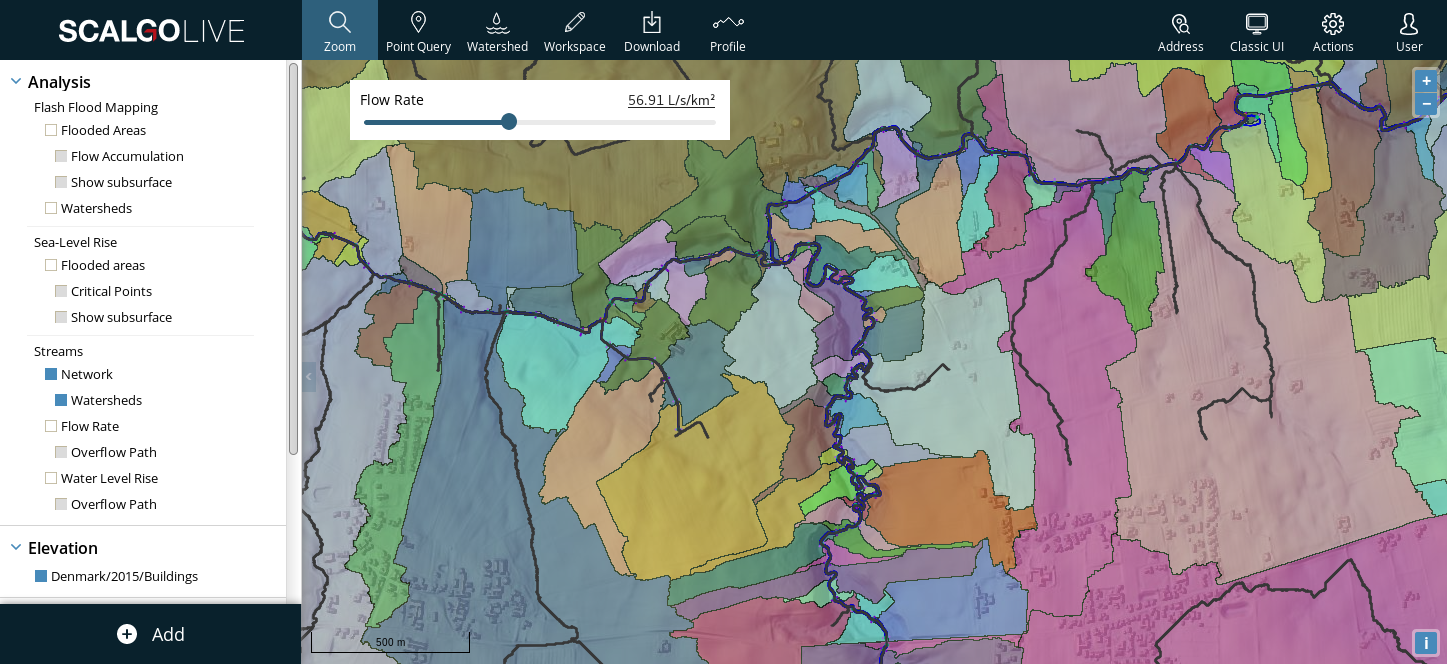-
Documentation
-
About
- Getting Started & Use Cases
- Support
-
What's new
- Specify basins and protrusions by drawing their outer boundary
- Simplified path features
- National Norwegian high-resolution land cover map
- Organise and communicate on a digital canvas
- New sidebar to help organize your analyses and queries
- Sliding contours
- Ny skyfallsanalys och en ännu bättre marktäckekarta
- New land cover map for Finland
- Depths in the depression map
- New Danish land cover map with more classes
- National Swedish High-Resolution Impervious Surface Mapping
- Watershed tool updated with even better descriptions of catchment characteristics
- National Flash Flood Map with Infiltration and Drainage for Denmark
- Add your own WMS layers to SCALGO Live
- Enriched building data in Denmark
- National hydrological corrections and Land Cover for Poland
- National hydrological corrections for Norway
- Updated Impervious Surface Mapping for Denmark
- National hydrological corrections and updated local data for Finland
- Fast and intuitive tools to work with infiltration and land use
- Improvements to vector imports and exports
- National Danish groundwater model
- New Sweden high-resolution model
- New powerful depression map and more analyses visualization options
- Introducing Modelspaces: Get your hydrodynamic models into SCALGO Live
- Use case videos
- Access a EA flood maps inside SCALGO Live
- Improved map export
- New powerful ways to edit the elevation model
- Better coloring of flooding layers and sea-level depth filtering
- National Danish High-Resolution Impervious Surface Mapping
- National access for local and regional organizations
- Simpler, more powerful downloads
- Customize Layer Transparency
- Hydrological corrections and new data in Sweden
- Improved export functionality
- Access a wide range of authorative data inside SCALGO Live
- Importing VASP data
- Measure gradients, undo edits, and Norway updates
- New terrain edit features, soil balance information and much more...
- Browse historical orthophotos in SCALGO Live
- Emergency planning with sea-level rise from national forecast data
- Detailed information about watershed composition
- Better styling of imported vector layers
- New Danish Elevation Model
- Work with gradients in the profile widget
- Flood risk screening from rivers and flow paths
- New workspace tool: Raise and lower terrain uniformly
- Importing LandXML TINs, LAS point clouds
- New model in Sweden
- Side slopes on workspace features
- Drag and drop enhancements
- Swedish contour maps
- Subsurface basins and sewage drains in workspaces
- New Interface
- Volume information for watersheds and flow paths
- New powerful tool for emergency response and coastal flood prevention
- Denmark: New flash flood map
- Sweden: Geodatasamverkan setting for Swedish users
- Import custom terrain models
- New Hydrological Corrections
- Elevation contours now available
- Download orthophotos as JPEG and PNG
- Subsurface structures in workspace
- Sea-levels in terrain profiles
- Updated orthophotos
- Models and analysis update
- User interface updates
- User interface updates
- GeoDanmark/FOT data, Matrikelkortet now available
- New flash flood map
- Download of risk polygons
- Updated orthophotos
- Nationwide hydrology on the new DHM/2015 model now available
- New flash flood map computation available with watershed download
- DHM/2015 variants and sea-levels now available nationwide
- DHM/2015 now available nationwide
- Hydrology on the new DHM/2015 model now available
- New DHM/2015 Model - now with buildings
- New DHM Model
- Watershed Tool
- Ad hoc layers
- Nationwide contour maps for all countries
- User Interface
- Canvas
- Analysis
- Workspaces
- Hydrodynamic Engine
- Streams and Flow
- Modelspaces
- Country Specific
-
About
Streams and Flow – Understanding
In this section, we discuss the fundamentals of interacting with stream networks in SCALGO Live. The principles in this section apply to the national stream network analysis as well as the ones in workspaces.
The screenshot below shows a user accessing a typical stream network setup. It looks and works the same regardless of whether or not it is based on a section of a stream or on an arbitrary flow path in the terrain. For simplicity of the disposition, we will refer to them both as stream networks.
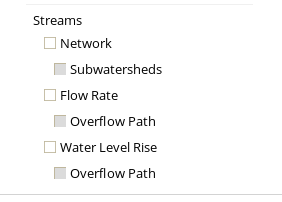
Layers
Network
The network layer shows the center line of the network. It is modelled as a network of nodes and edges with cross sections. Each edge is annotated with a cross section, and this is assumed to be constant over the length of the edge. In SCALGO Live, these cross sections are sampled directly from the elevation model. The stream network itself is rendered as a sequence of edges displayed in alternating shades of blue. An edge goes between two green nodes.
The cross section used to model the section of the stream covered by the edge is rendered as a thin purple line. The position, orientation and length of the line represent the measured part of the cross section. If you select an edge using point query, you can see the full length of the cross section used in the computations.
Subwatersheds
Subwatersheds show you how surface water is routed to the stream network. Read more about this in the section below called tracking subwatersheds along streams.
Flow Rate
Flow Rate is an analysis that shows the extent of a flood based on a user-chosen variable flow rate setting. Read more about this in the section below called Flow
Rate analysis.
Overflow Paths
The overflow paths shows indirect flood risk from the boundary of the area marked as flooded in the analysis. Read more in computations.
Water Level Rise
The water level analysis shows the flood extent based on a uniform increase in the water level of the stream. Read more about this in the section below called Water Level Rise analysis.
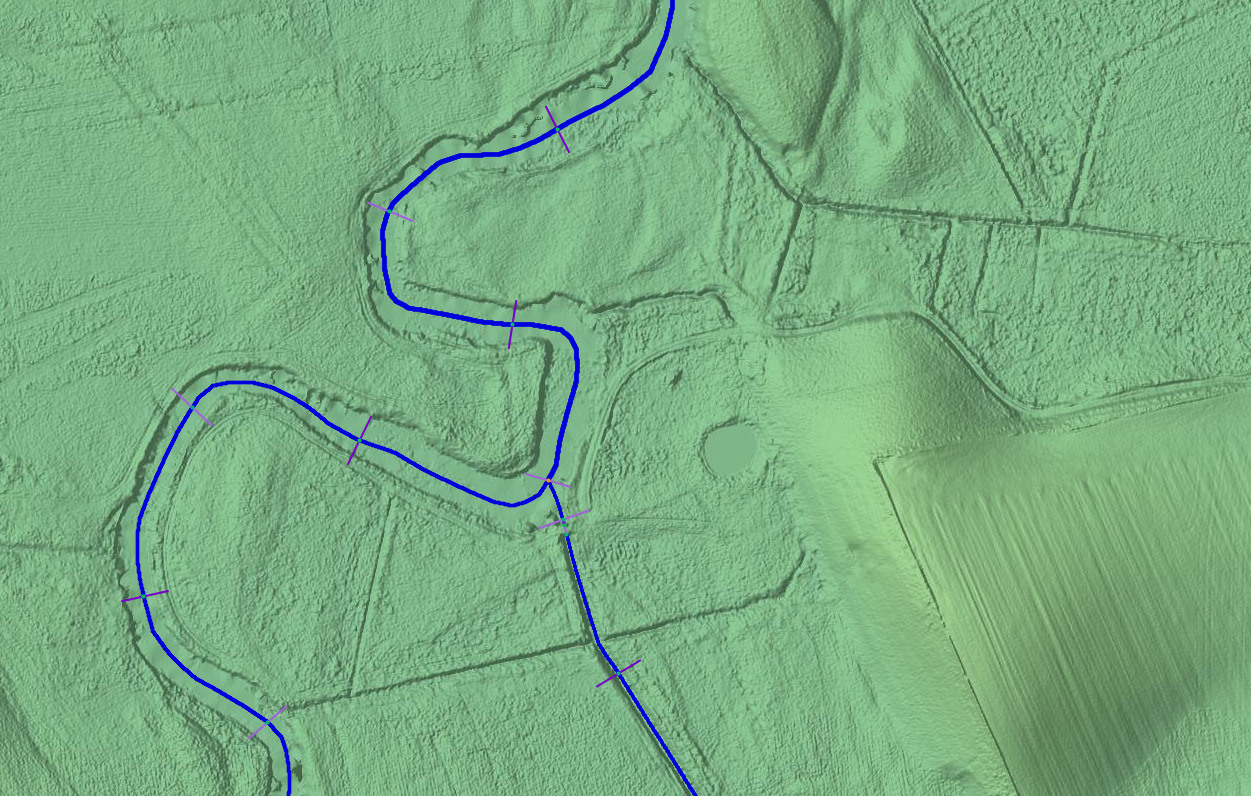
Flood risk screening
Stream networks are born with two types of computations and more are possible in workspaces. In the Flow Rate analysis, you can use a slider to select the flow in the stream and immediately see the effect of the chosen flow rate on the water level in the stream and onthe terrain. In the Water Level Rise analysis, you directly control the elevation of the water level relative to the elevation model (the bottom ofthe stream).
Flow Rate analysis
As mentioned above, the flow rate computation lets you pick an arbitrary flowrate. When the analysis is enabled, a slider appears that allows you to choose a flow rate and see the watershed of the stream. The default setting is in liters per second per square kilometer watershed. When running thecomputation, this is converted into an actual discharge value by multiplying the watershed area of the nodes in the stream network by the watershed size of that point. In this way, any given slider setting makes sense both for small and big streams. If you want to see the absolute flow value used at a location, you can use the length profile.
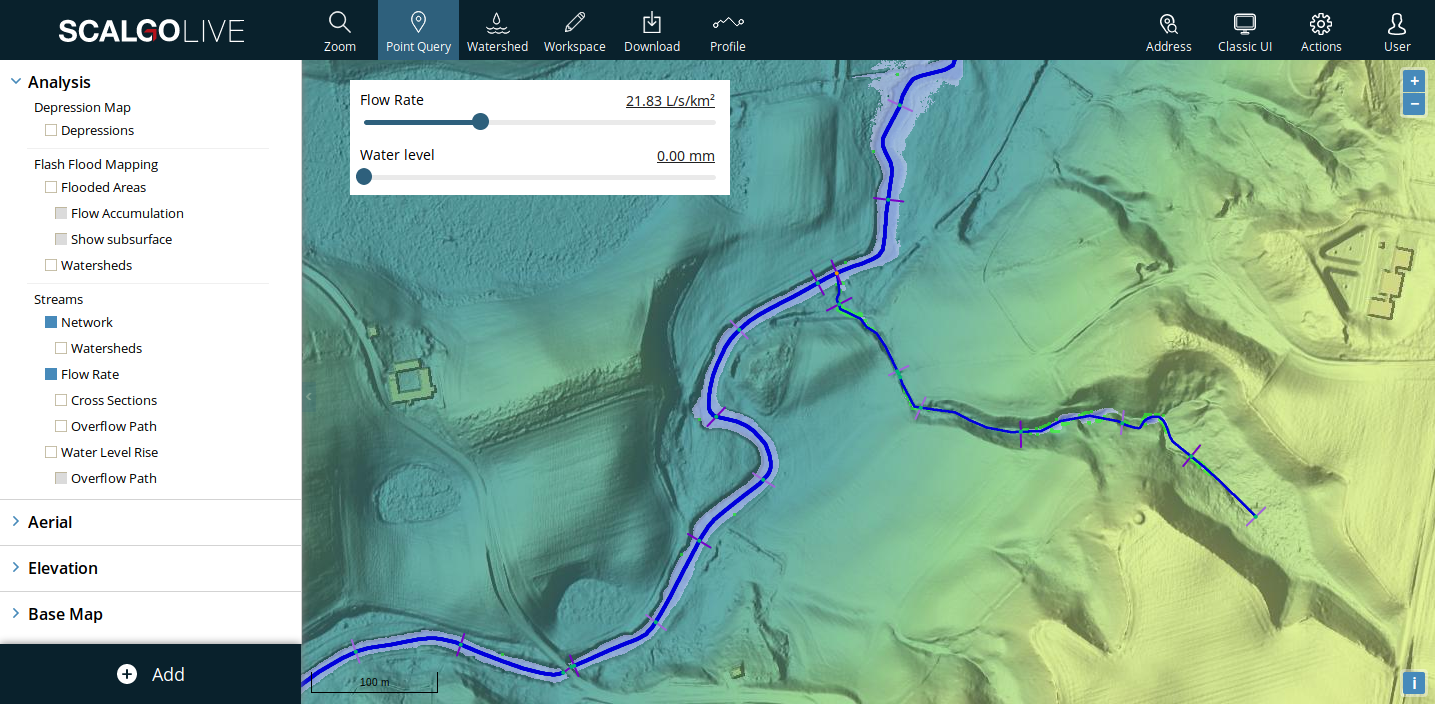
Water level rise analysis
In the water level rise analysis, you select how much of an increase in water level you want to model. The results show the increased water level along the stream network by the amount chosen. The water level is specified relative to the value of the elevation model along the stream. This is also useful for modeling an increase in lake and basin water levels.
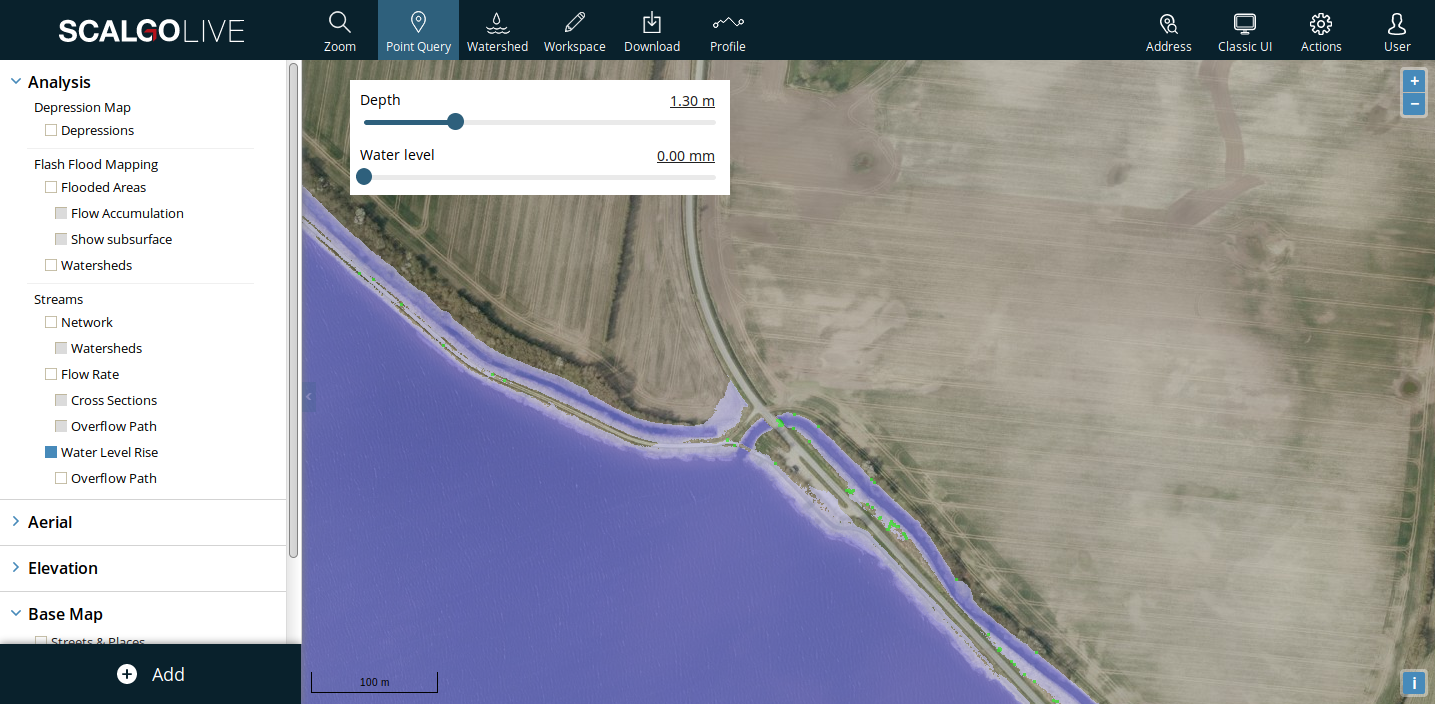
Exploring the stream network and analysis
There are a number of ways you can explore the stream network and the analyses. This includes length profiles, cross sections profiles and stream watersheds.
Point query
You can use point query to select any edge in the stream network by clicking on them on the map (remember to enable Network in the dock first). Once selected, the full extent of the cross section used in the computation is shown on the map and point info with further options appears. Point info lets you view the length and cross section profiles.
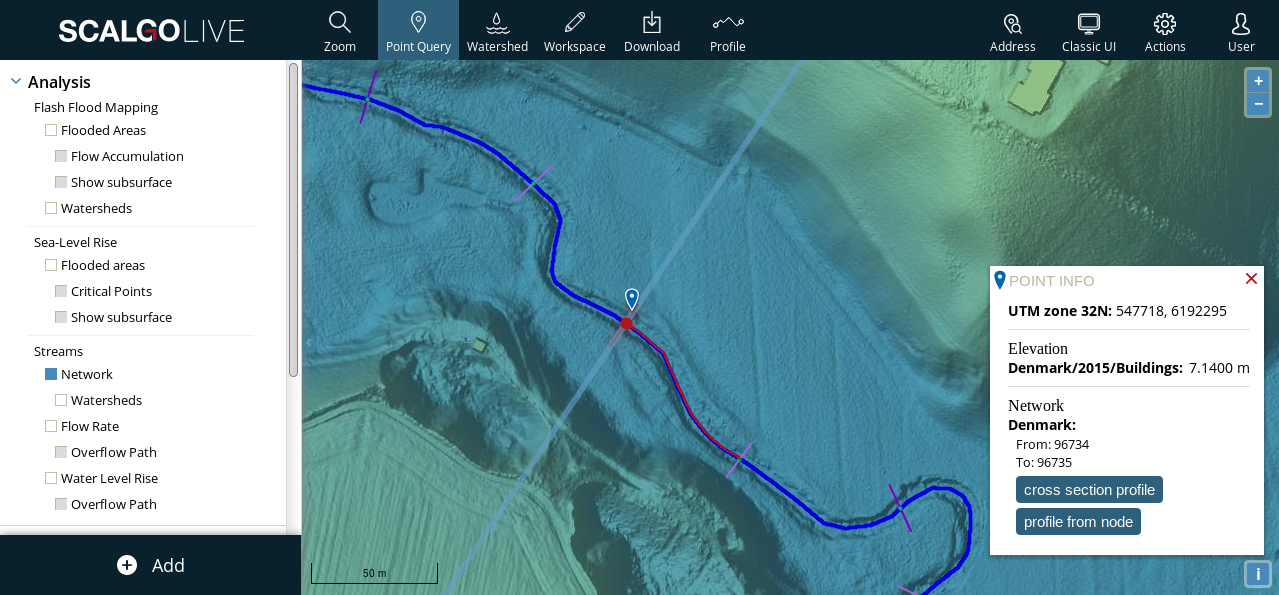
Cross section profiles
If you select cross section profile in point info, the cross section for that section of the network is displayed in the profile window. The bottom of the stream is marked with a green node.
Note that the cross section is sampled from an elevation, so if you want to change the cross section you can simply edit the elevation model using the standard workspace editing tools in a workspace.
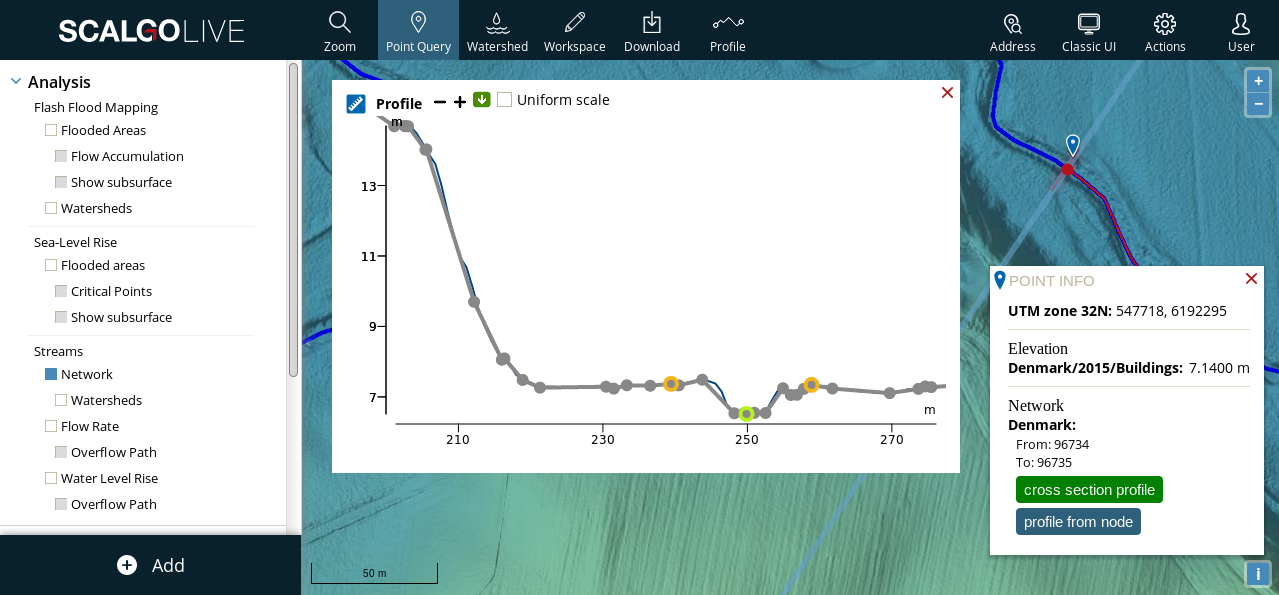
Length profiles
The length profile tool allows you to look at length profiles along a stretch in the stream network. Click on profile from node in point info, and then, click on another edge of the network downstream or upstream from the original point. After clicking on the second point, the length profile window will show. The length profile illustrates the elevation at the bottom of the stream and highlights the profiled section on the map. You can also enable any of the other profile-able layers in the dock and see that in the profile. For instance, if you enable an analysis, you will see the water level from the computation in the profile.
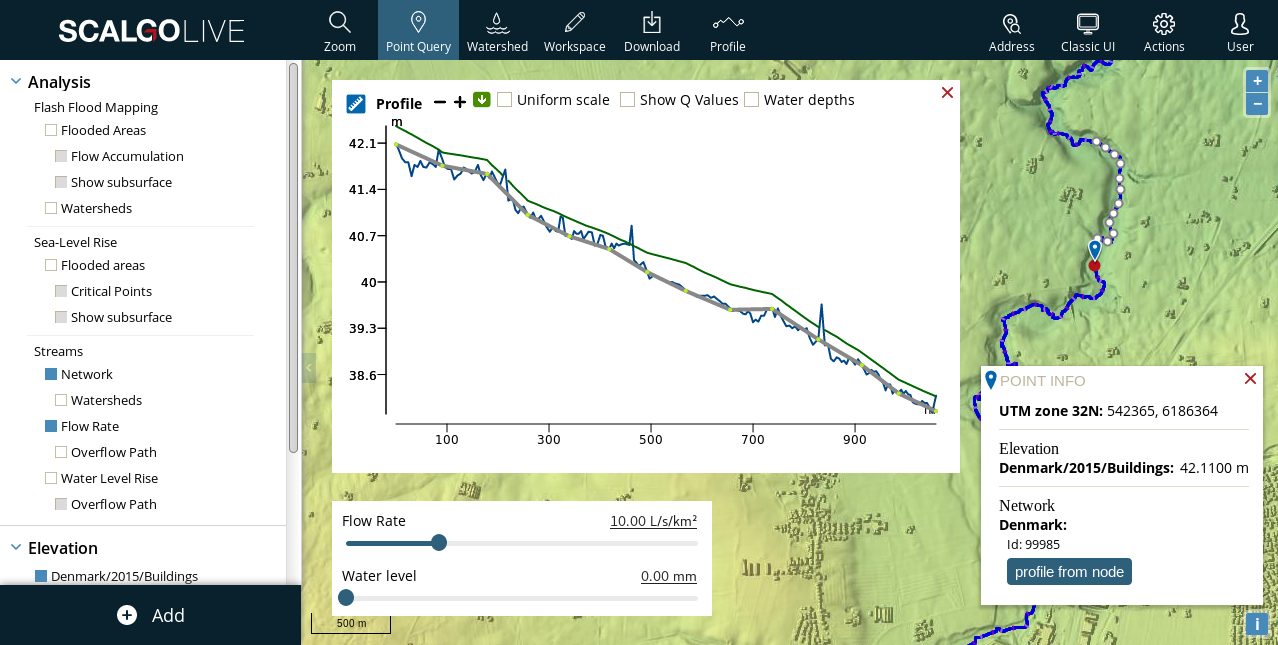
If you have selected a flow-based computation, you will also have the option to show the flow (the Q values) in the profile. Simply use the checkbox at the top of the profile window, as shown below.
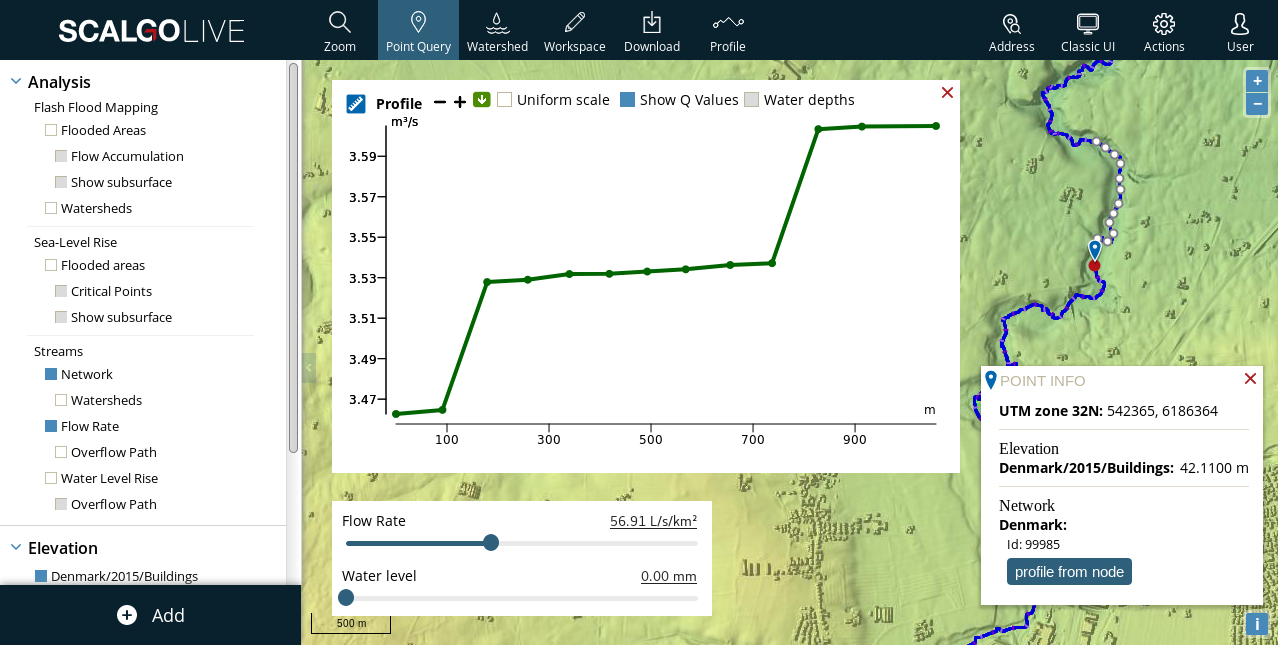
Tracking subwatersheds along streams
Subwatersheds shows you how surface water is routed to the stream network. It shows the subwatershed of each node in the stream network. The subwatershed is defined as the area of the terrain that has a flow path to the edge between two consecutive nodes along the stream. Large flow lines are also highlighted to make it easier to get an overview of larger watersheds. When a water level in the stream is modeled, it is transferred onto the terrain by going backwards up through the flow paths leading into the stream. Thus, it is also useful when trying to understand the outcome of a particular flooding scenario. For more information about subwatersheds, please read computations.
